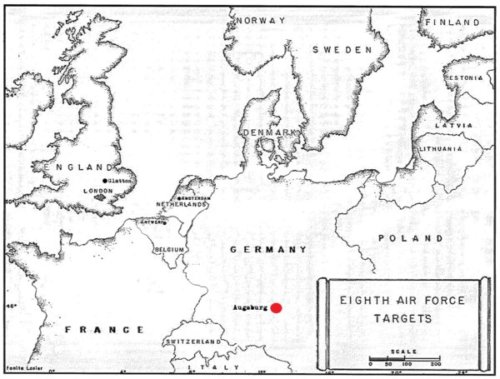TARGET: MESSERSCHMIDT PLANT
AUGSBURG, GERMANY
19 JULY, 1944

German jet propelled aircraft had become a potential menace to American heavy bomber formations. Augsburg was the center of development for the Me-262 jet fighter with much activity in evidence at nearby Lechfeld, Leipheim, Laupheim and other fields. Coordinated with widespread attacks on such targets were policing raids on the Schweinfurt ball bearing plants and the Messerschmidt plant at Augsburg. The 457th Group drew Augsburg as its target, furnishing thirty-six planes to form the entire 94th B Combat Wing as part of a force of 1242 Eighth Air Force heavies dispatched to southern Germany. The Messerschmidt plant had been the target for Mission No. 4 of the Group.
A new departure was made in the composition of boxes for deep penetration missions. For the first time the tactical twelve ship box was used on this type of mission. Lt. Col. Wilson was Air Commander and Captain Clarence E. Schuchmann was pilot. Lt. Johnston led the low box with Lt. Donald L. Seesenguth as pilot, and Major Syptak led the high box, with Lt. William K. Doherty as pilot. Lt. Col. Wilson led the three twelve ship boxes in the takeoff, with Captain Godfrey in the Deputy Lead plane. Take off and assembly were made without difficulty, with the Wing flying eighth in the Division formation. The flight took the formation by Aachen and thence across the Rhine through the Karlsruhe-Strasbourg flak gap. The entire route was covered with six to eight-tenths cumulus clouds, breaking to three-tenths near the IP.
Just before the turn to the IP, the formation was attacked by approximately forty FW-190s and Me-109s from all directions, but no saturation tactics were used. The pilots did not press their attacks. Only a few came in close before peeling off. However, the Deputy Lead craft, piloted by LI. Noel E. Cunefare and Captain Jerry Godfrey, was hit, Nos. 2 and 3 engines caught on fire, and the ship fell out of formation. It later exploded in mid-air. Four of the crew did not survive. Although these attacks continued all the way to Augsburg, no other losses were incurred.
The boxes took visual bombing intervals at the IP. Both the lead box and the low box, after making a smooth run, hit the hangar area on the east side of the field, which was the assigned area. The high box experienced difficulty in its lead plane and had poor results, the bombs falling in open fields and woods South of the target. Flak was intense, with eighteen craft Sustaining damage.
Good weather enabled all of the combat wings dispatched to bomb their targets visually. Destruction was extensive and one of the more successful missions of the war was accomplished.
The crew of Lt Noel E. Cunefare was lost on this date.

